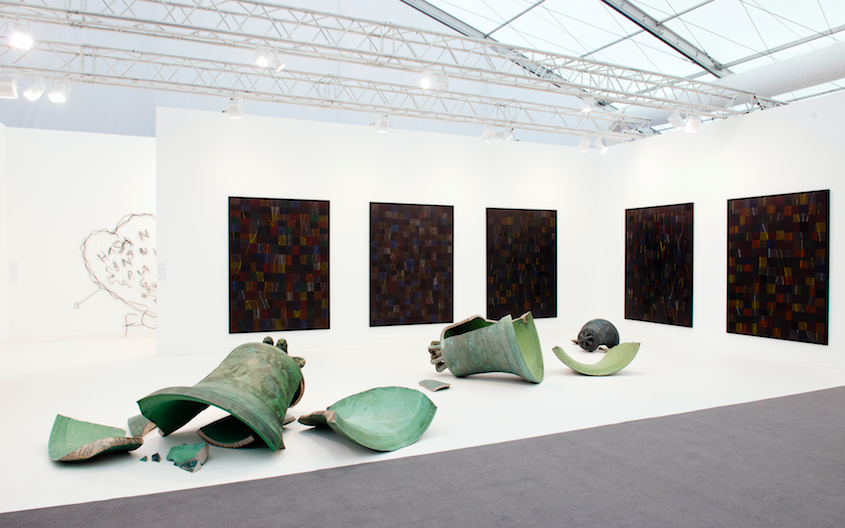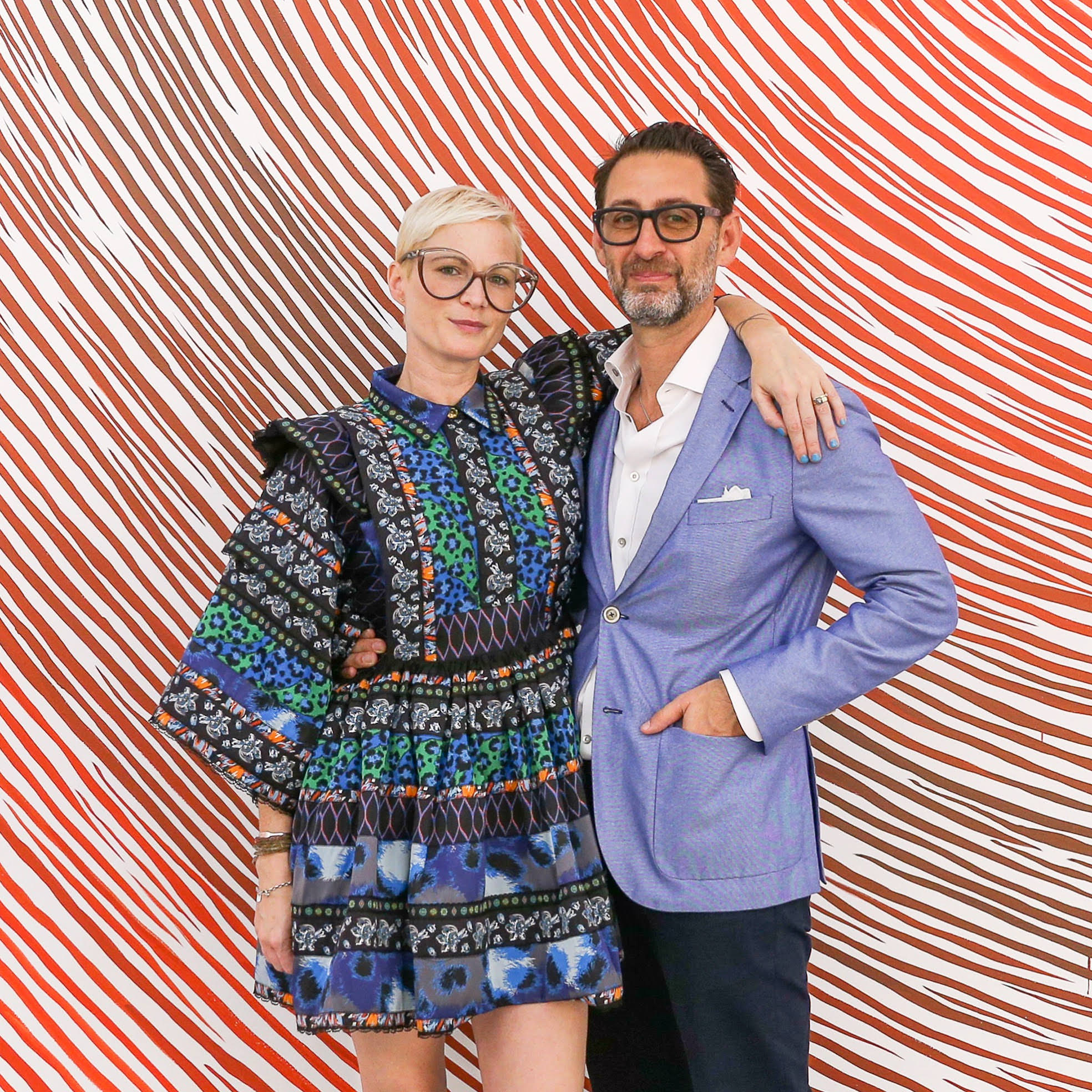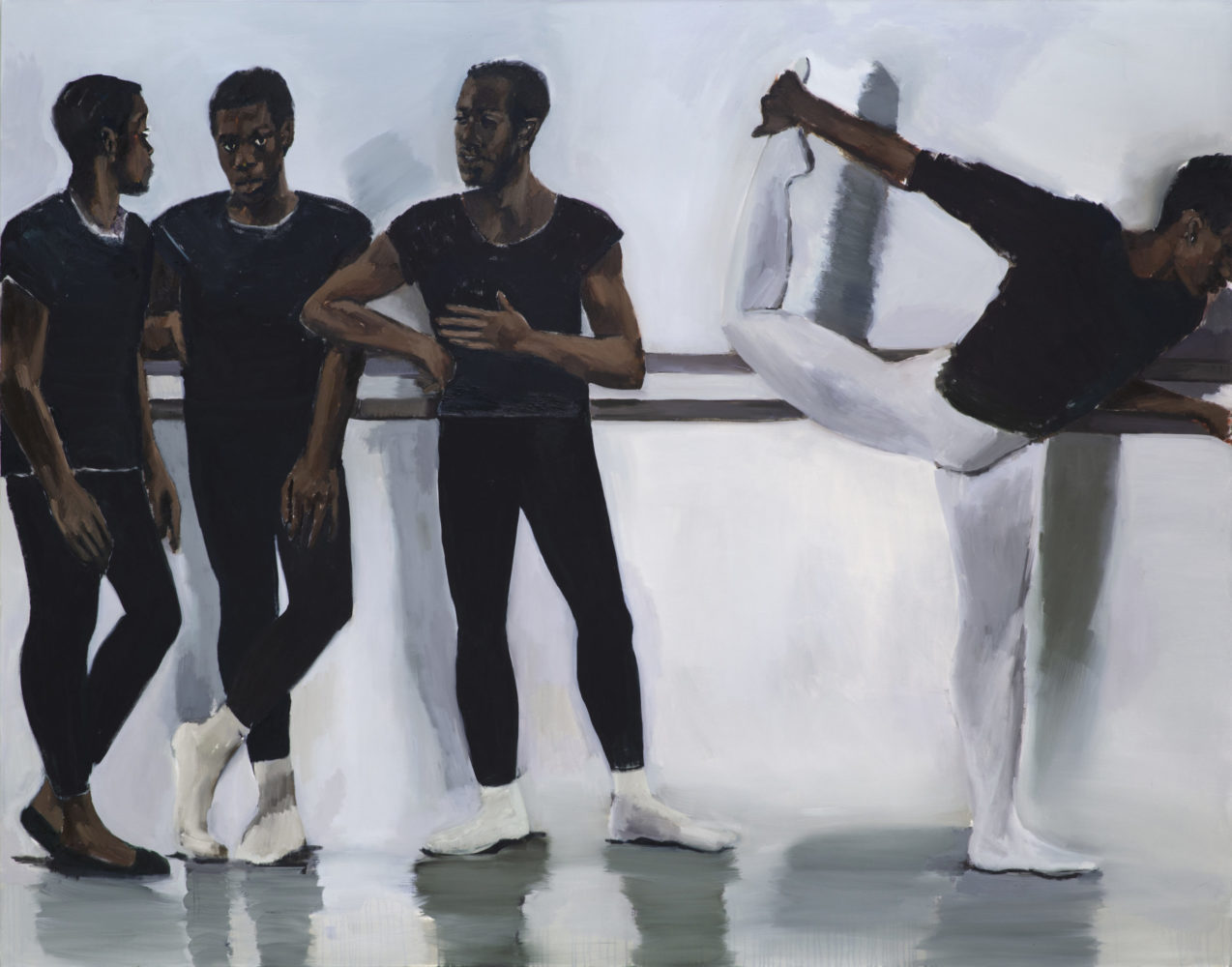British sculptor Nick Hornby (not to be confused with the author) and Indonesian colorist Sinta Tantra’s collaborative exhibition, “Sculpture At Work,” is currently on view through March 15 at One Canada Square in Canary Wharf – a major business district and public space in Tower Hamlets, London. No stranger to contemporary art, Canary Wharf has a decade-long history of commissioning award-winning art programs and installation, including a 300-meter bridge designed by Tantra in 2012. Hornby and Tantra, who met at the Slade School of Art over ten years ago, were already considering a collaboration when they were approached by Ann Elliott, chief curator at Canary Wharf. Despite the differences in how they make art – Hornby with monochromatic sculptures and Tantra with vibrantly colored murals and installations – One Canada Square became the ideal setting for a series of collaborative sculptures that activate an otherwise muted, utilitarian building.
Whitewall recently spoke with Hornby to learn more about his collaborative process with Tantra and upcoming projects.

Dan Miller
WHITEWALL: When you met Tantra at Slade School of Art, did you ever imagine a future collaboration?
NICK HORNBY: Sinta did painting and I sat on the fence between sculpture and fine-art media. In school, we didn’t often cross paths and I’ve tended to be a little suspicious of collaborative practices and never for a second thought I would become one.
WW: Your use of color and form is very different from Tantra’s, but you both are attentive to symmetry, pattern, and geometry.
NH: I agree, but it’s hard to pin down. From an art historical perspective our mediums, subject matters, and references are wildly different. Sinta explores her identity as an Indonesian woman through color, pattern, and pop culture references, whereas I reference modernist sculpture, classical architecture, and platonic solids. But peculiarly, I think we do share an aesthetic sensibility.

Aura Rosenberg
WW: What was the collaborative process like between the two of you?
NH: It was fantastic. I trust and respect Sinta enormously, but to begin with, we spoke different languages–and often smiled at each other in blank confusion. Then in an almost Neanderthal way, we developed a vocabulary of crude words and art references: doing a “Matisse Snail,” or a “Malevich Floater.”
WW: The objects in “Sculpture At Work” are very vibrant. How did you two decide on color choices and designs to complement Canary Wharf’s monochromatic environment?
NH: Since we were working on top of pre-existing sculptures, we decided to work with Sinta’s pre-existing palette. Our goal, in terms of color and design balances, was not to present a solution per se, but to make objects that pose some of the various questions that have arisen throughout studio research–surface, illusionistic space, and pattern. In the future, we hope to start from zero and co-author both object and image with shared rationale.

Gianfranco Baruchello
WW: You and Tantra have both made public art installations. Did this enhance the process?
NH: I think very much so. Artists who make work in the public domain have to be organized about everything from producing swaths of documents and scale drawings, to guaranteeing artworks against decay. We started in our usual manner – emailing each other designs – but as our vocabulary was limiting, we needed to work directly on the objects in the round. So, we produced the work ourselves in-house, in a rather ad-hoc, low fi way of doing, making mistakes, and re-doing.
WW: Cesar Pelli, the designer of One Canada Square based the design of the building on the similarly industrial World Financial Center, which was also the tallest building in the U.K. until 2010. With this in mind, how did you design a plan for such a distinctive building?
NH: Initially we looked at the site’s history, current use, formal qualities, but decided not to make work linked to any of its narratives. That said, we did make one piece as a literal intervention into the fabric of the building. Vast columns clad in marble that house the lift shafts support the entire tower. In collaboration with the photographer Sylvain Deleu, we made an enormous 50 foot photographic Trompe L’oeil of a Chevron protruding from the wall.
WW: The present is just a point (2012), your shortlisted proposal for the Victoria and Albert Museum, appears to be a new direction for your work, the sculpture points down from the ceiling and deals with a metaphysical subject more so than your public installations. What was your process in designing this proposal? Is it a hint at the direction of upcoming work?
NH: That extremely simple gesture was the solution to an extremely complicated brief. The cast courts at the V&A contain over 700 years of texture, ideas, and histories, all on display in one room. I wanted the sculpture to engage with the narrative of the cast collection, but also to deal with the physical specificity of the location, a tall gallery with a glass roof. This sculpture did both, and also worked in a wonderfully interactive way with the audience. After seeing this enormous and dramatic white object, you are drawn to walk underneath the point where you look up and see the iconic outline of Michelangelo’s David framed by the sky. David represents the apotheosis of the grand narrative of human perfectibility, all moving to a single point. This object simply extended that idea into physical space. It plunged David through a digital algorithm, and reduces him to a pinpoint.
In the future, I would like to try to pare things down. I’m still trying to find that knife edge between the raw and the cooked.
Born in 1980, Nick Hornby often works in pure monochromes. Masters such as Rodin, Brancusi, and Calder influences him. His interpretive design process involves elaborate line drawings and digital models, which enable him to deconstruct the master sculptures he references. His work raises awareness about authorship while combining historical and contemporary approaches to address the handmade and technological and the original with the interpreted.
He has exhibited internationally at prestigious institutions such as Tate Britain in London and The Hub in Athens. His awards include the Clifford Chance Sculpture Prize, the Deidre Hubbard Sculpture Award, and the Blind Art Prize. In 2009, he was shortlisted for the first Spitalfields Sculpture prize and the Mark Tanner Sculpture Prize. Additionally, his work has been featured in Artforum and Dazed and Confused, and ES magazine has described him as “The New Gormley.”
He lives and works in London.








